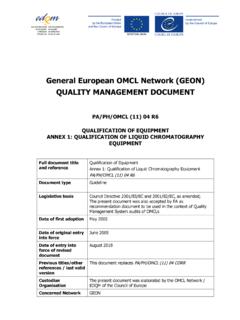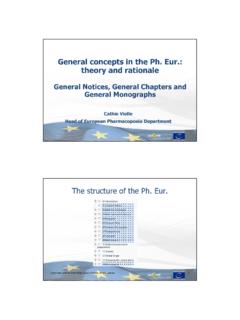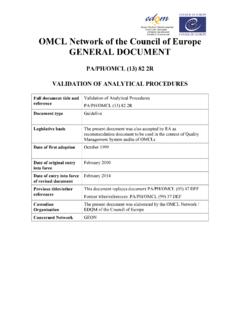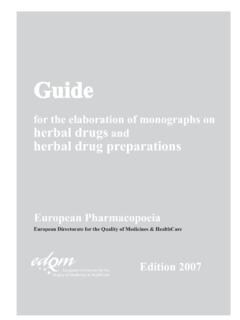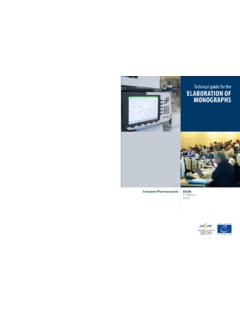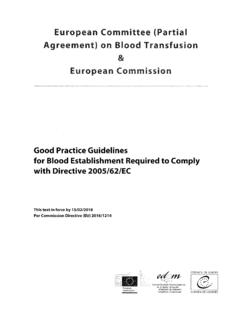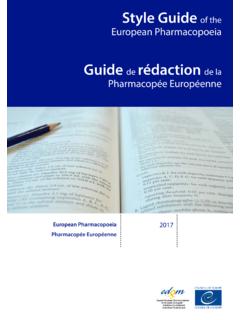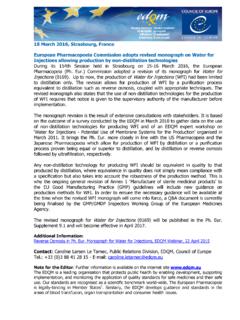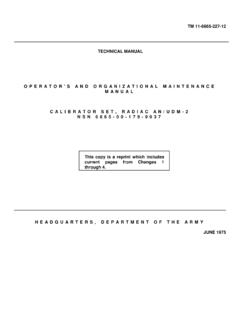Transcription of OMCL Network of the Council of Europe QUALITY …
1 OMCL Network of the Council of Europe QUALITY management document PA/PH/OMCL (12) 77 7R QUALIFICATION OF equipment ANNEX 8: QUALIFICATION OF BALANCES Full document title and reference Qualification of Balances Annex 8 to the OMCL Network Guideline Qualification of equipment PA/PH/OMCL (12) 77 7R document type Guideline Legislative basis Date of first adoption August 2013 Date of original entry into force December 2013 Date of entry into force of revised document n/a Previous titles/other references / last valid version n/a Custodian Organisation The present document was elaborated by the OMCL Network / EDQM of the Council of Europe Concerned Network GEON PA/PH/OMCL (12)
2 77 7R 2/11 ANNEX 8 OF THE OMCL Network GUIDELINE QUALIFICATION OF equipment QUALIFICATION OF BALANCES 1. INTRODUCTION This document is the 8th Annex to the core document Qualification of equipment , which together should be used when planning, performing and documenting the qualification process of balances. The core document contains the introduction and general forms for Level I and II of qualification, which are common to all types of instruments. Annex 8 contains instrument-related recommendations on parameters to be checked at Level III and IV of qualification and the corresponding typical acceptance limits, as well as practical examples on the methodology that can be used to carry out these checks.
3 2. AIM AND SCOPE OF THE GUIDELINE This guideline describes the requirements for balances (electronic - digital) used in chemical and biological tests in OMCLs. The following types of balances are considered in this guideline (Table 1): Table 1 Type Ordinary name Number of digits after decimal position (g) Accuracy Class 1. Ultra Micro Balances 7 I 2. Micro Balances 6 I 3. Semi-micro Balances 5 I 4. Analytical Balances 4 I 5. Precision Balances 1 to 3 II 6. Technical Balances 0 to 1 III The classifications are based on the OIML R 76-1 International Recommendation document (see Table 2). 3/11 OMCL (12) 77 7R Table 2: The verification scale interval, number of verification scale intervals and minimum capacity in relation to the accuracy class of an instrument.
4 Accuracy class Verification scale interval (e) Number of verification scale intervals (n = Max/e) Minimum capacity (Min) (Lower limit) minimum maximum Special I g < e (*) 50 000 (**) - 100 e High II g < e < g g < e 100 5 000 100 000 100 000 20 e 50 e Medium III g < e < 2 g 5 g < e 100 500 10 000 10 000 20 e 20 e Ordinary IIII 5g < e 100 1 000 10 e * It is not normally feasible to test and verify an instrument to e < 1 mg due to the uncertainty of the test loads.
5 ** For an instrument of class I with d < mg, n may be less than 50000. The minimum capacity is reduced to 5 e for grading instruments, instruments that determine a transport tariff or toll ( postal scales and instruments weighing waste material). On multiple range instruments, the verification scale intervals are e1, e2, .., er with e1 < e2 < .. < er. Similar sub-scripts are also used with the terms Min, n and Max. On multiple range instruments, each range is treated as if it were an instrument with one range. For special applications that are clearly marked on the instrument, an instrument may have weighing ranges in classes I and II, or in classes II and III.
6 The instrument as a whole shall then comply with the more severe requirements of Variations due to influence quantities and time applicable to either of the two classes (see OIML R76-1 International Recommendation document ) Max = Maximum capacity of the balance e = verification scale interval e1, ei, er = verification scale interval, rules for indices 3. CONSIDERATIONS FOR LEVEL I AND II OF equipment QUALIFICATION At Level I of the qualification of balances (selection of instruments and suppliers), it is recommended to select a manufacturer of balances that can satisfy the needs of the laboratory and works under ISO 9001 certification.
7 At Level II of the qualification of balances (installation and release for use), it is recommended to check all the requirements set during the selection of the instrument and calibration should be performed before putting into service by an accredited external service supplier, or internally by appropriately qualified personnel, using certified reference weights according to an approved procedure. PA/PH/OMCL (12) 77 7R 4/11 4. REQUIREMENTS FOR BALANCE USE Location of the Balance The accuracy and precision of weighing results are closely associated with the location of the balance.
8 OMCLs should ensure that the balance can work under optimal conditions (weighing room/laboratory, weighing bench, temperature, light, air, etc.). It is recommended that balances of types 1 to 6 (see Table 1 above) are located in a specially designed weighing room that is vibration-proof, dust-free and has an anti-static floor. For substances that are sensible to static electricity it is also possible to use an ionising unit. If a balance of type 1 to 6 is located in a laboratory outside of the weighing room, then the weighing bench on which it is placed should be in a separate part of the laboratory that is vibration-proof and dust-free.
9 For balances of types 1 to 4, a stable bench should be used. It should be ensured that the weighing bench is stable, no matter from what material it is made. The weighing bench should not deform when work is carried out on it and it must be vibration-proof or the transfer of vibrations must not influence the weighing process. If there is a risk of instability, the balance should be equipped with a stability indicator so that the weight is only registered or printed after stabilisation of the balance. The weighing bench should be non-magnetic ( no steel plates) and protected against electrostatic charges (no plastic or glass).
10 Temperature As weighing results are influenced by temperature, OMCLs should ensure a constant temperature is maintained in weighing rooms/laboratories. The typical drift of balances of types 1 and 2 is 1-2 ppm/ C. The deviation should not exceed more than 5 C per hour. Atmospheric humidity The optimum relative humidity (% RH) during a weighing process is between 40 % to 60 % for balances of class I and II (see Table 1). The relative humidity may be expanded to 20 % to 80 % in cases where the accuracy and linearity of measurements are not affected. Light Balances should be protected from direct sunlight (heat).
